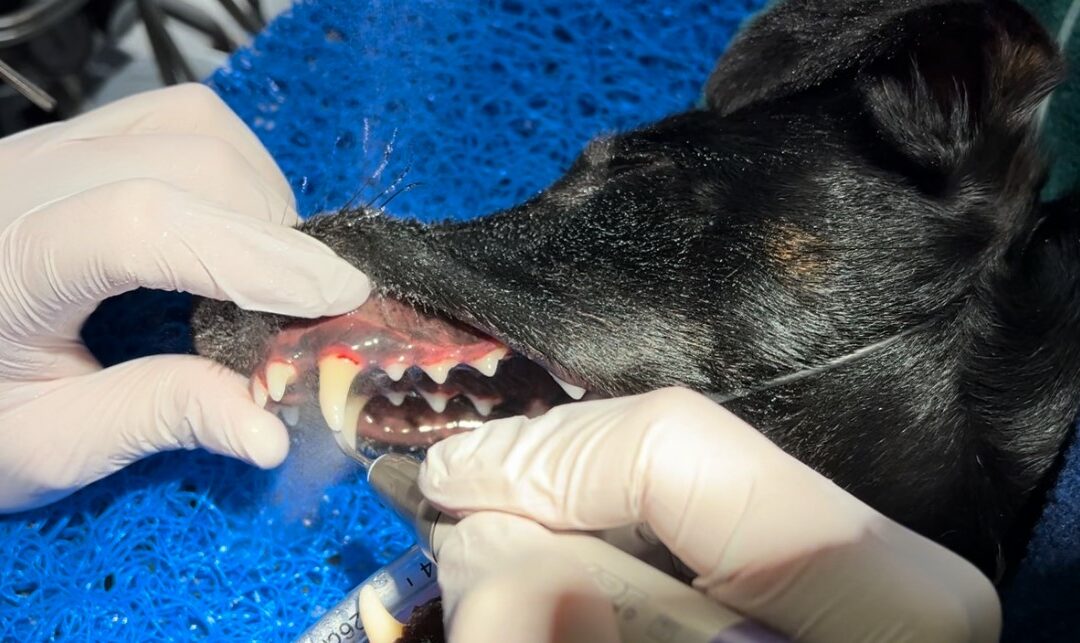When we humans go to the dentist and they recommend fillings or extractions, we usually find it’s done in a separate appointment. We will have our teeth cleaned and checked, radiographs taken, and from there our dentists make a plan for the next appointment where the dental work is actually performed.
We will often recommend the same model for our pets when they require multiple teeth to be taken out or the extractions will be complex; referred to as staged dentals.
In a staged dental, stage one focuses on planning and preparation. The veterinarian will perform a comprehensive oral health exam and charting, looking for any abnormalities in the oral cavity, teeth, and gums. We then take a series of dental radiographs to assess the teeth, jaw, roots and supporting structures below the gum line. The veterinarian will use this information to determine which teeth are causing disease and pain and if they need to be removed. We will also ultrasonically clean each tooth and gumline to improve mouth health and comfort.
Stage two is where the veterinarian performs any necessary extractions. We use local nerve blocks to numb the mouth, the same as ours when we have dental surgery. Extraction techniques used may vary depending on the tooth to be extracted or the extent of disease. This may involve sectioning of a tooth (cutting it into pieces) or sometimes removal of bone from the jaw.
Some benefits of separating the planning stage from the surgical stage include:
- Safer procedures. Because our pets have to go under general anaesthesia for dental procedures, there are elements to staging dentals that decrease risk. We can use different drugs or a lighter plane of anaesthesia for stage one as we don’t need to control for pain. Shorter anaesthetic times also mean that within the procedure your pet is better able to maintain their blood pressure, temperature, and less interventions are often needed to keep them stable.
- Healing of mouth structures. A lot of the visible signs of dental disease are caused or exacerbated by bacteria and inflammation in the mouth. In a staged dental the cleaning of the teeth and below the gum line mean that this bacteria is removed and allows the gums and other periodontal structures to heal. This means at stage two there’s improved gum and tissue health, better suturing compliance, extraction healing, and lowers the risks of infection, reducing need for unnecessary antibiotic use.
- Communication with you. When a dental is planned and performed all in one procedure the patient is under anaesthesia the whole time. We move from the vet’s assessment of the oral health exam and radiographs straight to the surgical phase with limited time to discuss with you. When these are separated, we can focus on getting all the information we need and waking the patient up as soon as possible. When they’re ready to go home, the veterinarian will spend time with you to show you the radiographs, explain the findings and plan, identify any potential challenges, and formulate the smoothest and safest surgical experience for your pet. In this way you get to be part of their decision-making process and aware of your pet’s expected outcome and experience on the day. You too will then have time to plan for their post operative care and ongoing home dental management.
- Focused team. By separating the surgical component of a staged dental, the veterinarian is able to approach this part dedicated, refreshed and with a clear picture of what is being performed that day.
Staging dentals won’t always be appropriate for every pet. Going under anaesthesia is a risk in itself and staging means this happens twice. Some pets may have conditions that mean the risk of two procedures out way the benefits of a staged dental. We will also sometimes have the resources to perform a complex dental all the way through. Our skilled veterinarians will always assess your individual pet’s health profile to determine what would be best for them.




